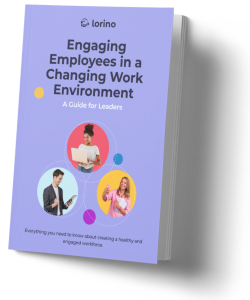One often overlooked aspect of fostering a positive work environment is cultivating joy.
While joy may seem frivolous and even abstract in the context of a professional workplace, research has found that it is actually a critical factor in employee engagement.
It not only makes employees feel appreciated, but it has a impact on motivation and productivity.

But how do companies create a culture of joy?
This article explores the research-backed strategies for increasing joy in the workplace and how they can improve employee engagement.
What is Joy in the Workplace?
Joy itself is quite a complex emotion, but in the context of the workplace, it is generally defined as a feeling of satisfaction and enthusiasm for one’s job.
This could be expressed through motivated work, creative problem-solving, a sense of connection with colleagues, and a positive outlook on work tasks.
Although closely related, joy is not the same as happiness — while happiness is more emotional and short-lived, joy is a feeling of purpose and engagement that lasts longer.
Happiness in the workplace is maybe achievable through fun activities, bean bags, pizza parties, etc. However, in order to cultivate joy, organizations need to focus on creating the right environment.
The Relationship between Joy and Engagement
According to the Oxford Research Encyclopedia of Psychology, work engagement is defined as “a configuration of vigor, dedication, and absorption that motivates exceptional work performance”.
And by now it's widely known that employee engagement has a direct impact on organizational success, from higher productivity to increased retention rates.
But since engagement is this elusive feeling of emotional investment, it's very hard to quantify and measure, and even harder to increase.
It's similar to intrinsic motivation, as it needs to come from within and the only thing that companies can do to try and increase their employees' engagement is to foster a work environment that encourages it.
And that's where joy comes in.
Although it's far from being the only factor in engagement, it's easy to see how people would be more invested (and therefore more engaged) in something that brings them joy rather than something they are just doing out of obligation.
The ‘good life’ is described by philosophers and psychologists as consisting of authentic expression of self, a sense of well-being, and active engagement in life and work.
So the link between engagement and joy goes both ways. An engaged employee is more likely to experience joy, and an employee that experiences joy is more likely to be engaged.
Strategies for Creating a Joyful Work Culture
It therefore stands to reason that if companies want higher levels of engagement then they need to create a culture where employees can find joy in their work.
And while that is a huge undertaking with a lot of moving parts, there are some simple strategies you can start with to create a joyful work culture.
1. Build Strengths Into Day to Day Work
According to some positive psychology scholars, strengths can be catalysts to cultivating joy. These strengths are natural energizers, and building them into the working day can boost the feeling of joy.
These, however, will be different for all people. Some are natural-born planners, and for them, a day filled with planning may be energizing. Others might take pleasure in helping others grow and learn—in this case, activities that allow them to teach and mentor will bring joy.
So in order to be able to create an environment that will be joyful, understand the strengths of your team and design activities that will help them use their strengths for work.
That will not only streamline the working process but also make it enjoyable for everyone involved!
2. Professional Growth and Development
There’s not one guide on employee engagement out there that won’t be telling you that offering growth and development opportunities is essential for employee engagement.
And there’s more than one good reason for that.
For one, when opportunities for growth and development are offered, it shows that employees are valued by their employers and they understand that these employees need to develop themselves in order to reach their highest potential.
And it’s also easy to see how everyone will be inspired and motivated to do better work when they know that there is a possibility of progression or recognition for their efforts.
In terms of joy and fulfillment, however, growth and development opportunities can be a true game changers because of the nature of learning in humans.
Ethnographic research into how children learn shows that the joy of learning results from the effort they put in — from persistent work through difficulties that leads to success in achieving meaningful goals.
So it’s not just about expanding your skillset or acquiring knowledge, it’s about doing something meaningful, even though it's hard.
That’s why growth and development opportunities are key to a meaningful and joyful work experience that leads to satisfied employees who bring their best ideas and efforts to the table.
3. Encourage Authenticity
Joy and psychological well-being are almost interchangeable terms, as one can’t exist without the other. And research suggests that authenticity is integral to psychological well-being.
But being authentic is more than just knowing yourself. It's also about being able to share how you feel and think in a safe environment, and often that’s what's missing in the workplace.
Be it that your employees are afraid to share their ideas, or that they feel disconnected from their peers, creating an environment of trust and connection is key to fostering authenticity.
That means giving all employees a voice and acknowledging the ideas they bring to the table. It also means creating opportunities for genuine interactions between colleagues and encouraging collaboration over competition among team members.
And when everyone feels heard, respected, and appreciated, it’s much easier for them to be themselves at work – which leads to greater joy and engagement in their work.
4. Foster Cohesion
Whilst we’re on the topic of connectedness and cohesion - Joy is not just an individual phenomenon; it’s what psychologists call “affiliative,” which means it spreads from one person to another.
The more connected your team members are, the higher likelihood of joy-spreading in the workplace.
So investing in team building activities, social events, and even just regular lunch outings can go a long way not only in building team morale but fostering a culture of joy in the workplace.
This is particularly hard and important if the team is geographically dispersed or working remotely. Finding ways to have colleagues connect on a deeper level than just working together is essential for creating a workplace of joy.
So try implementing social intranets, online or virtual team-building activities, and regular check-ins with colleagues who may be feeling particularly disconnected.
In Conclusion
Many managers will feel like it’s not their job or responsibility to create a joyful work environment. After all, they are there to get the job done.
But a workplace of joy is not only a more pleasant place to be but one that is far more productive and successful.
So if not for the sake of creating a work environment that employees will love and be passionate about, do it for the sake of your company’s bottom line.
In the end, I leave you with this paraphrased quote: In summary, if joy researchers can define its limits and help cultivate it in appropriate ways, joy may have the greatest potential among psychological phenomena to promote human flourishing and address modern challenges

